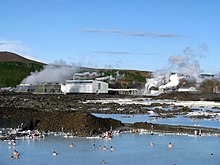Blue Lagoon (geothermal spa)


The Blue Lagoon (Icelandic: Bláa lónið [ˈplauːa ˈlouːnɪθ]) is a geothermal spa in southwestern Iceland. The spa is located in a lava field near Grindavík and in front of Mount Þorbjörn on Reykjanes Peninsula, in a location favourable for geothermal power, and is supplied by water used in the nearby Svartsengi geothermal power station. The Blue Lagoon is approximately 20 km (12 mi) from Keflavík International Airport, and is one of the most visited attractions in Iceland.
Description[]
The water's milky blue shade is due to its high silica content.[1] The silica forms soft white mud on the bottom of the lake which bathers rub on themselves.[2] The water is also rich in salts and algae.[3]
The water temperature in the bathing and swimming area of the lagoon averages 37–39 °C (99–102 °F). Guests are required to shower prior to using the geothermal spa. The communal showers are split up by gender.[4] Children age 8 and under are only allowed entry with the use of arm floaters, provided free of charge. The lagoon is not suitable for children under the age of 2 years. The lagoon is accessible for wheelchair users with a ramp that extends into the water and a shower chair. There is also a private changing room available for those with special needs.
History[]
Water source[]
The lagoon is man-made. The water is a byproduct from the nearby geothermal power plant Svartsengi where superheated water is vented from the ground near a lava flow and used to run turbines that generate electricity. After going through the turbines, the steam and hot water passes through a heat exchanger to provide heat for a municipal water heating system. Then the water is fed into the lagoon.
The rich mineral content is provided by the underground geological layers and pushed up to the surface by the hot water (at about 1.2 MPa (12 bar) pressure and 240 °C (464 °F) temperature) used by the plant. Because of its mineral concentration, water cannot be recycled and must be disposed of in the nearby landscape, a permeable lava field that varies in thickness from 50 cm (20 in) to 1 m (3.3 ft). After the minerals have formed a deposit, the water reinfiltrates the ground, but the deposits render the ground impermeable over time, so the plant needs to continuously dig new ponds in the nearby lava field.
The water renews every 2 days.[2] The average pH is 7.5 and the salt content is 2.5%.[2] Very few organisms live in the water apart from some blue-green algae, despite the water not being artificially disinfected it contains no fecal bacteria, environmental bacteria, fungi, or plants.[2]
Baths[]
Shortly after the opening of the Svartsengi power plant in 1976, the runoff water had made pools. In 1981, a psoriasis patient bathed in the water and noted that the water alleviated his symptoms[5] and the lagoon subsequently became popular.[6] Bathing facilities opened in 1987 and in 1992 the Blue Lagoon company was established.[6]
Studies made in the 1990s confirmed that the lagoon had a beneficial effect on the skin disease psoriasis.[2] A psoriasis clinic was opened in 1994[6] and in 1995, the Blue Lagoon company began marketing skin products containing silica, algae, and salt.[6]
The lagoon recorded 1.3 million visitors in 2017,[7] up from 919,000 visitors in 2015.[8] The company had a revenue of €102 million and a profit of €31 million in 2017.[7] It has over 600 employees.[7] The entry fee is from $64.[9]
See also[]
References[]
- ^ "Hvernig varð Bláa lónið til?". Vísindavefurinn (in Icelandic). 27 July 2015.
- ^ a b c d e Olafsson, J (December 1996). "The Blue Lagoon in Iceland and psoriasis". Clinics in Dermatology. 14 (6): 647–651. doi:10.1016/S0738-081X(96)00099-5.
- ^ Gross, Daniel (5 April 2008). "Iceland's Energy Lessons". Newsweek.
- ^ "Archived copy". Archived from the original on 2017-06-17. Retrieved 2017-06-08.CS1 maint: archived copy as title (link)
- ^ Valur Margeirsson. "Leiðrétt útgáfa um tilurð Bláa lónsins". Víkurfréttir (in Icelandic). Archived from the original on 2019-03-08. Retrieved 2019-03-18.
- ^ a b c d "History of the Blue Lagoon" (PDF) (presentation deck) (in Icelandic). Blue Lagoon.
- ^ a b c Helgi Magnússon. "Annual Report of the Chairman of the Board for 2017". Blue Lagoon (in Icelandic). Retrieved 2019-03-18.
- ^ "919,000 visited Iceland's Blue Lagoon in 2015". Iceland Monitor. Retrieved 2020-01-09.
- ^ Batarags, Katie Warren, Lina. "Disappointing photos show what Iceland's famous Blue Lagoon looks like in real life". Business Insider. Retrieved 2020-01-09.
External links[]
| Wikimedia Commons has media related to Blue Lagoon. |
 Blue Lagoon travel guide from Wikivoyage
Blue Lagoon travel guide from Wikivoyage- Official website
- Information from Reykjavik's tourist organization
- Blue Lagoon panoramic virtual tour
- Blue Lagoon Discover Iceland Tours
Coordinates: 63°52′48″N 22°26′53″W / 63.88000°N 22.44806°W
- Hot springs of Iceland
- Spas
- Tourist attractions in Iceland
- Reykjanes